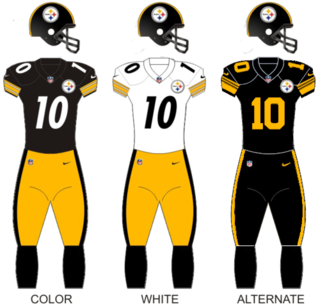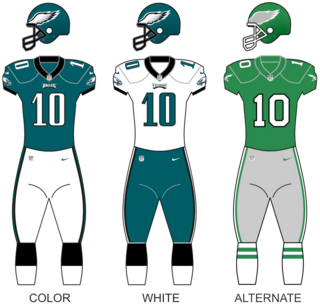Related Research Articles

De Benneville "Bert" Bell was the National Football League (NFL) commissioner from 1946 until his death in 1959. As commissioner, he introduced competitive parity into the NFL to improve the league's commercial viability and promote its popularity.

The Pittsburgh Steelers are a professional American football team based in Pittsburgh. The Steelers compete in the National Football League (NFL) as a member club of the American Football Conference (AFC) North Division. Founded in 1933, the Steelers are the seventh-oldest franchise in the NFL, and the oldest franchise in the AFC.

The Philadelphia Eagles are a professional American football team based in Philadelphia. The Eagles compete in the National Football League (NFL) as a member club of the league's National Football Conference (NFC) East division. The team plays its home games at Lincoln Financial Field in the South Philadelphia Sports Complex.

Arthur Joseph Rooney Sr., often referred to as "the Chief", was the founding owner of the Pittsburgh Steelers, an American football franchise in the National Football League (NFL), from 1933 until his death. Rooney is a member of the Pro Football Hall of Fame, was an Olympic qualifying boxer, and was part or whole owner in several track sport venues and Pittsburgh area pro teams. He was the first president of the Pittsburgh Steelers from 1933 to 1974, and the first chairman of the team from 1933 to 1988.

The National Football League Draft, also called the NFL Draft or (officially) the Player Selection Meeting, is an annual event which serves as the league's most common source of player recruitment. Each team is given a position in the drafting order in reverse order relative to its record in the previous year, which means that the last place team is positioned first and the Super Bowl champion is last. From this position, the team can either select a player or trade its position to another team for other draft positions, a player or players, or any combination thereof. The round is complete when each team has either selected a player or traded its position in the draft. The first draft was held in 1936, and has been held every year since.

Charles Henry Noll was an American professional football player and head coach. Regarded as one of the greatest head coaches of all time, his sole head coaching position was for the Pittsburgh Steelers of the National Football League (NFL) from 1969 to 1991. When Noll retired after 23 years, only three other head coaches in NFL history had longer tenures with one team.

Walter Andrew Kiesling was an American football guard and tackle who spent 36 years as a player, coach, and aide with National Football League (NFL) teams. He was posthumously inducted into the Pro Football Hall of Fame in 1966 and was named to the NFL 1920s All-Decade Team in 1969.
The Steagles were the team created by the temporary merger of Pennsylvania's two National Football League (NFL) teams, the Pittsburgh Steelers and the Philadelphia Eagles, during the 1943 season. The two franchises were compelled to field a single combined team because both had lost many players to military service during World War II. The league's official record book refers to the team as "Phil-Pitt Combine", but the unofficial "Steagles", despite never being registered by the NFL, has become the enduring moniker.
The 1943 NFL season was the 24th regular season of the National Football League.
The Pittsburgh Steelers are an American football franchise representing Pittsburgh. They are the seventh-oldest club in the National Football League (NFL), which they joined in 1933. The only surviving NFL teams with a longer history are the Chicago Bears, Arizona Cardinals, Detroit Lions, Green Bay Packers, New York Giants, and Washington Commanders. The Philadelphia Eagles joined the league concurrently with the Steelers in 1933.
Card-Pitt was the team created by the temporary merger of two National Football League (NFL) teams, the Chicago Cardinals and the Pittsburgh Steelers, during the 1944 season. It was the second such merger for the Steelers, who had combined with the Philadelphia Eagles in 1943 to form the "Steagles". The arrangement was made necessary by the loss of numerous players to World War II military service, and was dissolved upon completion of the season. The war ended before the start of the 1945 season, and both teams resumed normal operations.
The 1943 season was the Chicago Bears' 24th in the National Football League. The team failed to match on their 11–0 record from 1942 and finished at 8–1–1, under temporary co-coaches Hunk Anderson and Luke Johnsos. On the way to winning the Western Division, the Bears were, yet again, denied a chance at an undefeated season by the defending champion Redskins in Washington. The Bears had their revenge in the NFL title game and defeated the Redskins at Wrigley Field to claim their sixth league title. It was their third championship in four years, establishing themselves as the pro football dynasty of the early 1940s.
The Pennsylvania Keystoners was the idea for an American football team thought up by then-Pittsburgh Pirates owner, Art Rooney, in 1939 to have a single National Football League franchise based in both Pittsburgh and Philadelphia. The team would play half of its home games in each location.
The 1955 Philadelphia Eagles season was their 23rd in the league. They failed to improve on their previous output of 7–4–1, winning only four games. The team failed to qualify for the playoffs for the sixth consecutive season. 1955 marked the end of an era, as the last remaining Phil-Pitt Steagle, longtime player Bucko Kilroy, retired after 13 seasons in the NFL, all of them with the Eagles, going back to when they were known as the Steagles.
The 1941 season was the Philadelphia Eagles' ninth in the National Football League (NFL). The team improved on their 1–10 record from the previous season, but just barely, winning two games, and they missed out on the playoffs again.
The 1940 Philadelphia Eagles season was their eighth in the National Football League. The team failed to improve on their previous output of 1–9–1, losing ten games. The team failed to qualify for the playoffs for the eighth consecutive season.
Joseph Daniell Hoague was a professional American football player in the National Football League (NFL) with the Pittsburgh Steelers, and later the Philadelphia-Pittsburgh Steagles, and the Boston Yanks. Prior to joining the NFL, Hoague played college football at Colgate University.
John M. Hinkle was an American football player and coach. He played professionally in the National Football League (NFL) with the New York Giants, Philadelphia Eagles and the "Steagles". Hinkle later became a football coach, and was head coach at Drexel.

Alexis Thompson was an owner of the National Football League (NFL)'s Philadelphia Eagles, Pittsburgh Steelers, and Philadelphia-Pittsburgh Steagles. Prior to his executive career, he was a field hockey player who competed in the 1936 Summer Olympics for the United States team, which was eliminated in the group stage of the Olympic tournament. He played one match as forward.
The Eagles–Steelers rivalry is a National Football League (NFL) rivalry between the Philadelphia Eagles and the Pittsburgh Steelers. Unofficially nicknamed "The Battle of Pennsylvania", this is an in-state, interconference rivalry between the two NFL teams located in the state of Pennsylvania.
References
- ↑ Ruck, Patterson & Weber 2010, pp. 95–97.
- ↑ Ruck, Patterson & Weber 2010, p. 96–97.
- ↑ Ruck, Patterson & Weber 2010, p. 175.
- ↑ MacCambridge 2005, p. 43; Lyons 2010, p. 63.
- ↑ MacCambridge 2005, p. 43; Claassen 1963, p. 335; Lyons 2010, p. 63.
- ↑ Lyons 2010, p. 63; Claassen 1963, p. 342.
- ↑ Ruck, Patterson & Weber 2010, p. 174.
- ↑ Ruck, Patterson & Weber 2010, p. 180.
- ↑ "Dodgers 10, Steelers 3". Meriden (CT) Record . September 30, 1940. p. 4. Retrieved May 17, 2011.
- ↑ Ruck, Patterson & Weber 2010, p. 173.
- 1 2 Rooney & McHugh 2008, p. 49.
- ↑ "Thompson to Keep Pros Here; Say Sale Price is $160,000". Pittsburgh Press . December 10, 1940. p. 30. Retrieved May 18, 2011.
- 1 2 "Boston Seeks Transfer of Pro Steelers to Hub". Pittsburgh Press . March 10, 1940. p. 14 (second section). Retrieved May 18, 2011.
- 1 2 "Rooney Sells Pro Football Club to Boston Promoter". Pittsburgh Press . December 9, 1940. p. 26. Retrieved May 17, 2011.
- 1 2 "Yale '36, Age 6, Bucks "6", Describes Steelers' Owner". Pittsburgh Press . December 11, 1940. p. 16. Retrieved May 18, 2011.
- ↑ Ruck, Patterson & Weber 2010, p. 183.
- 1 2 "Rooney Tells How Big Deal Was Arranged". Pittsburgh Post-Gazette . December 10, 1940. p. 18. Retrieved May 18, 2011.
- ↑ Ruck, Patterson & Weber 2010, pp. 183–184; MacCambridge 2005, p. 45.
- ↑ Lyons 2010, p. 82.
- 1 2 3 Ruck, Patterson & Weber 2010, p. 184.
- ↑ "Plenty of Reskins 'Bit the Dust' — and How!". Pittsburgh Press . December 9, 1940. p. 26. Retrieved May 17, 2011.
- ↑ "Rooney Sells Steelers; Club Stays Here". Pittsburgh Post-Gazette . December 10, 1940. p. 18. Retrieved May 18, 2011.
- 1 2 "How Players Are Divided in Grid Deal". Pittsburgh Post-Gazette . December 10, 1940. p. 18. Retrieved May 18, 2011.
- ↑ "1940s put Steelers to tests that nearly break them". Post-Gazette . September 16, 2007. Retrieved December 21, 2019.
- ↑ "Thompson Pledges to Rebuild Steelers". Pittsburgh Press . December 19, 1940. p. 34. Retrieved May 18, 2011.
- ↑ "Iron Men New Name of Steelers". Pittsburgh Post-Gazette . January 17, 1941. p. 19. Retrieved May 18, 2011.
- ↑ "Rooney, Thompson Swap Franchises, Transplant Players". Pittsburgh Press . April 3, 1941. p. 28. Retrieved May 18, 2011.
- 1 2 3 4 Ruck, Patterson & Weber 2010, p. 186.
- ↑ "Rooney's Team Shifts Back Here; Thompson Will Take Pittsburgh Pros to Philly in Big Deal". Pittsburgh Post-Gazette . April 3, 1941. p. 18. Retrieved May 18, 2011.
- 1 2 Dvorchak, Robert (August 27, 2007). "Blood Brothers: The 1943 Steagles became an unlikely product of the war years". Pittsburgh Post-Gazette . Retrieved December 21, 2019.
- ↑ Shuck, Barry (November 5, 2016). "History lesson: When the Eagles became the Steelers". SB Nation: Big Blue View. Vox Media, Inc. Retrieved 2016-11-06.
- ↑ Ruck, Patterson & Weber 2010, p. 187; Lyons 2010, p. 88; MacCambridge 2005, p. 45.
- ↑ Braunwart, Bob; Carroll, Bob; Horrigan, Joe (1982). "Pennsylvania Polka" (PDF). The Coffin Corner . Professional Football Researchers Association. 4 (10): 1–4. Retrieved February 4, 2017.
- ↑ Didinger, Ray; Robert S. Lyons (2005). The Eagles Encyclopedia . Temple University Press. pp. 127–128. ISBN 1-59213-449-1.
- ↑ "1940 Philadelphia Eagles Starters, Roster, & Players".
- ↑ "1941 Philadelphia Eagles Starters, Roster, & Players".
- ↑ "1940 Pittsburgh Steelers Starters, Roster, & Players".
- ↑ "1941 Pittsburgh Steelers Starters, Roster, & Players".